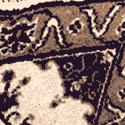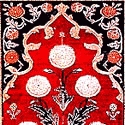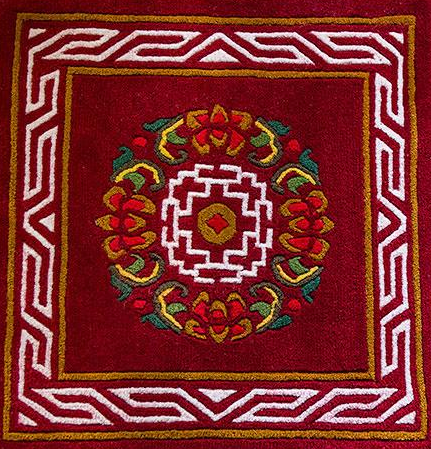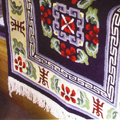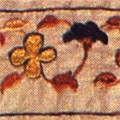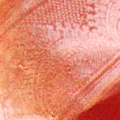Masulipatnam is an important carpet-weaving centre in Andhra Pradesh. The weaving of Indo-Persian carpets here began with the settling of the Arab community in the area. The vocabulary of carpet-weaving gradually fused with the local language, with the central ground of the carpet being called the khana and the border becoming known as the anchu. The patterns used are named after fruits or flowers like babul, ambarcha, guava, and jampal. The main designs on the carpets are named after the patrons of the carpet-industry: for instance, Ramachandra khani, Reddy khani, and Gopalrao khani. Other common names include Nurjehan, Shah Nawaz, Gulbanthi, Farasi, and Shahnammal. The designs are mainly floral or geometrical and the combination of shades is often a blue and green mixed with soft yellow and pastels. The carpets of Eluru and Warrangal are the pride of Andhra Pradesh. Carpet-weaving at Warangal began when the Mughal army --- which included artists and craftespersons -- moved into the Deccan region. Since the area around Warangal grew abundant cotton and was also known for weaving, thus carpet-weaving began flourishing here without great difficulty. Originally the local short-staple wool was used but now fine carpets are being manufactured by using long-staple wool from Bikaner. Most of the weavers are men; only a few women have been trained in the craft. Here also, the designs are often named after patrons. Mahbub khani, Teerandas khani, Hashim khani, Dilli khani, and Thotti khani are examples of this practice. The designs are again of Indo-Persian origin. Complicated designs are woven and the traditional talim technique is also present. Most often, the background is off-white and the designs are in deep green and orange. Dilli khani has boats (kishti) and floral motifs, and Thotti khani is a design-composition built around flower-pots (thotti means a clay flower pot). In 1885, these carpets, known as Deccan rugs were part of the British Empire Exhibition held at London and received an award for fine workmanship.
Carpet weaving calls for a high degree of skill and dexterity and is generally done by the Monpa women in West Kameng and the tribes of North Siang, district apart form the Tibetan community settled in the area. Carpets are woven in bright colours with predominantly Tibetan motifs such as the dragon or geometric and floral designs, reflecting the Tibetan-Buddhist influence in the area. Wool colours were originally obtained using vegetable and other natural dye sources, although synthetic dyes and chemicals are now commonly used.
Knotted pile carpets produced without using any mechanical contrivance are artistically created by Gujarat's carpet-weavers. The only tools used are a knife for cutting the weft after the knot has been tied, a panja made of iron for beating in the weft and the pile tufts, and a pair of scissors for cutting the pile level. Traditionally, vertical wooden looms are used for weaving.
The kind of carpets made in Kashmir resemble Central Asian styles like bokhara and Turkish makes. Often, a cotton warp is mixed with a woollen weft. Silk carpets are also made. Medallions, horse designs, and hunting and animal scenes are the motifs used. Floral and plant designs in unusual sizes can also be found. Trellis designs, the hallmark of Mughal traditions, are combined with plant motifs. Medallions in many varieties and shapes are found along the borders. In these carpets, repetition does not give rise to monotony. Since carpet-weaving originated in Persia and travelled to Kashmir, the designs are mostly local variations of Persian themes. In addition to the design, the knotting of the carpet is the most important aspect determining durability and value. Kashmiri carpets are always hand-knotted. A carpet is extremely expensive and considered as a lifelong investment. The carpet industry provides employment to a large section of the local population and also earns a fair amount of foreign exchange. The carpets woven in Ladakh are an integral part of the culture there. The community of Buddhists in Ladakh prepare carpets chiefly for personal use. The people in the area have been weaving the carpets from very early times. These are used as the main form of furnishing in a region where temperatures dip to extreme lows. The carpets are used for sitting on during the day and sleeping at night, as well as to seat guests and in ceremonies and feasts. The basic Tibetan style which is 3 inches x 6 inches is known as the khalidal. These carpets are woven by looping knots known as khabdan. The designs woven into the carpets are generally drawn from religious motifs, inspired by the symbols of Mahayana Buddhism.. Barajasta is the technique in carpet-making where the main design is worked out in pile and the background has a plain weave in gold thread which adds a lustrous appearance. Bokhara carpets are made in pure wool and three rows of irregular octagons form the main motif. Other geometrical motifs are used sometimes as are leaf patterns; the motifs at the edges include the 'tree of life', diamonds, herringbone, and latch hooks. The colours used are ivory, red, blue, and green. The background is usually in mahogany, mauve, yellow, dark green, and burnt almond or orange. The skeletal warp of the carpet is stretched tightly on the frame and the weft threads are passed through the talim or design, after which the colour specifications are worked out. Woollen carpets are very well-known in Kashmir and they are called kalin. Shawl weavers here took to carpet weaving as this has a better demand. Talim, a weaver's alphabet in shawl-making, started being used for carpet-weaving. The colour card has the dyed pieces of thread attached to it to indicate the colour combination to be used. The talim is organised in graphical manner, with each square standing for one knot, with the design being built up on this basis. The talim and the shade-card or the rang-ticket as it is called are combined together for the weaving operation. The talim writer may take up to three months to finalise it, depending on the number of knots per square inch. Indian carpets are distinguished by the panalidar back or pronounced ribs running down the back of the carpet. Modern carpets have a smooth back and the quality is not very good.
The main centre is Gwalior where carpet-weaving began in the early part of this century and the designs are traditional.
Traditionally, the northeastern belt weaves hand-knotted woollen carpets with bold colourful designs on upright wooden frame looms. The method of weaving and the motifs and colour schemes are similar in the entire belt. The warp of the carpet is cotton and is mounted on the upper beams while the woven fabric is wound on the lower beam. Knotting is done, with great skill and dexterity, by looping the woollen thread around the warp. The rod used for looping is placed along the warp. When a motif or a new colour is introduced, the ground colour is cut and the new colour thread is inserted by twisting into a single warp thread and looping. The loops are finally cut with a knife and a pile is created. The number of knots per square inch could vary from 40 to 100. The patterns are mainly geometrical, using different colours to build the shapes. Bold floral designs or symbolic Tibetan motifs are also used. The colours are bright and bold and vegetable dyes are used.
The women of the Bhutia community of Sikkim practice what is perhaps the oldest form of carpet-weaving in the world. They traditionally weave hand-knotted woollen carpets with chiefly Tibetan designs on upright wooden frame-loom.
The warp - taan of the carpet is cotton and is mounted on the upper beams while the woven fabric is wound to the lower beam. Knotting is done, with great skill and dexterity, by looping the woollen thread around the warp, and the rod which is used for looping is placed along the warp. When a motif or a new colour is introduced, the ground colour is cut and the new coloured thread is inserted by twisting into a single warp thread and looping. The loops are finally cut with a knife and a pile is created. The number of knots per square inch could vary from 40 to 100. The design is first drawn on the graph paper and later translated in the weaving process.
The method of weaving and the use of decorative motifs and colour schemes are unique to this community. The patterns commonly woven on to the carpets are stylised floral motifs, compositions borrowed from Buddhist iconography, eight Buddhist lucky signs, geometrical designs, and most popularly, Tibetan designs like a dragon holding a ball in his mouth or the two mythical Tibetan birds called the dak and the jira. Tibetan designs have a wide range and each has a significance and name of its own. The overall effect on the carpet is a single, powerful, bold design. Geometrical patterns are created using knots of different colour. Vegetable and natural dyes are still used to obtain the right colours. Besides regular carpets the Bhutia women also weave small bedside carpets and squares called asans to sit on. Their weaving techniques are being extended to dhurrie-weaving and woollen dhurrie-weaving.Woollen pile carpets have played a prominent part in the textile history of Pakistan. At present in Pakistan a wide variety of carpets and floor coverings are being produced.
The craft of weaving wool is a characteristic of the hills of Uttarakhand, initiated by the women of the villages. This craft has become indivisible from the lives of the natives, the Bhotias and the Gadvalis, even though the craft only took roots in the region just 3-4 generations back. Earlier a few nomadic tribes undertook the task of weaving woolen carpets, however now many more people have taken to the craft, and are weaving a variety of products. Many organizations have set about the task of teaching weaving and setting up looms to help the craft prosper. When talking about the craft, woolen carpets of the Bhotia are the most famous and the oldest form of the craft. Bhotias are a Tibetan nomadic tribe in Uttarakhand. Their winter months are spent in Dhunda, in an effort to obtain wool and weave fabrics while the summer months are spent in Harsil, growing beans, potatoes, apples and almonds. The charge of rearing sheep and procuring and preparing the wool is taken up by the tribe itself. September to October is considered to be the business time. Traditionally yarn is spun on the spinning wheel or the Charkha, after which it is ready to be knitted or woven. Two types of looms are taken in to use while weaving. For the coarser wool an upright loom is used while for finer wool the pit loom is used. Knitting, done with a pair of needles has attained a different level of fabric construction altogether with the motifs transforming into three dimensional textures. Sheep wool is often mixed with rabbit hair to attain extra softness, shimmer and whiteness to the weave. Once the fabric is made, it is washed and brushed to give a felt like effect. As a result of the blending of white and black wool in definite ratios, before spinning of the yarn, different shades of grey in the woolen fabrics area naturally obtained. Tibetan motifs which have a higher demand, has replaced the traditional Bhotia designs. The designs can be characterized by two broad categories, stylized geometric motifs and the floral and dragon designs exhibiting a Chinese influence. While many carpets are woven from memory, typically the design is followed by looking at the reverse of a finished carpet or from a colour graph. Bhotias sell their woolen products at annual fairs at Bageshwar, Jaulgibi and Thal. The Tibetan carpets have a popular international market too. Popular products made the Bhotias are knitted Kangsuk (socks), Saai (cap), Laakshu (glove), mufflers and woven suit lengths, shawls, dan (carpet), stoles, dumkar (banket) and paagad (belts).
In the high altitudes of Himachal Pradesh, sheep and goat rearing is a very common occupation for many villagers who are involved in blanket-weaving and felting. The Giabong and Kulu valleys are the main areas for gudma, the local name for a fleecy, soft, and heavy blanket which is woven by the local villagers in natural colours and finished with a warm red or black trimming. Mattresses locally called kharchas are made of woollen yarn derived from goat's hair. Numdha, a craft fairly new to Himachal Pradesh involves felting the wool and ornamenting it with colourful embroidery threads. The carpets of Himachal are rich and captivating in design and durable in texture. Dragons borrowed from the neighbouring country of China and the Hindu swastikas are popular motifs which get incorporated in these carpets. Many Tibetan craftspersons are engaged in weaving woollen carpets in the villages of Bhuppur, Puruwala, Sataun, and Kamsan in the Paonta block of Sirmur district. The cold climate in the hills in this region makes the carpet an item of daily use. The patterns woven are mainly geometric and blocks of colour are used in the patterns. Threads of ground colours are used; they are cut off when a new motif or design has to be introduced. The weaving is a combination of cotton and wool and it is done by women. Bhutias are traditional weavers who make common bedside carpets called duns with 60 knots to a square inch. Asans, with squares to sit on, are also made. The motifs are inspired from alpana or rangoli designs drawn on the floor during festive occasions and they are geometric or floral. Mythical Tibetan birds called dak, jira, dragons, lions, and the god of lightning are common motifs. The Central Asian influence can be seen in the presence of the famous key and swastika designs. Chali is a coarse carpet found in Lahaul which is a remote mountainous area in the far north. Kinnaur in Himachal pradesh is noted for its fine weave. The residue wool left after the material for pashmina shawls has been taken is used to weave a rough yarn called sheli from which carpets --- called karcha, chuktu, and chugdan --- are made. Black and white carpets are woven from a mixture of sheli and bakratha, another kind of goat's wool Thobis are black and grey carpets made from goat's hair at Pangi in the Chamba district of Himachal Pradesh. The motifs found on these carpets are the trishul (trident), the swastika, and an eight-pointed design made of a combination of a diamond and a concentric circle. Although wool carpets are predominant in the region, a wide range of cotton dhurries are also made. The main colours used are red or blue, and the design comprises usually of stripes. Weavers of Sirmur use pit-looms. Varying effects are produced by using yarn of differing thicknesses, thin for the warp and thick for the weft.
Carved and turned wood work is widely practiced across several regions in Punjab.Products like chairs, peg tables in Hoshiarpur, containers called singhardaani in Jalandhar, low stools called peedi, wooden slippers called khadavan, butter churners, rolling pinks, wooden handles for tava, chairs, tables, beds and screens in Batala. Tools such as chisel, file, tool sharpener, saws, clippers, planers and drills are required for the crafting process.
The Bhutanese do carving extensively in wood, slate or stone, for making items such as printing blocks for religious texts, masks, furniture, altars, and the slate images adorning many shrines and altars. Carving, however, is not confined to wood stone and slate only - some of the most exquisite and rare carving of images of deities has been done on rhino horns and ivory and adorns various temples.

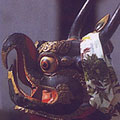
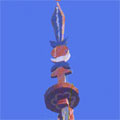


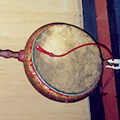
In Nepal, though the terracotta tradition goes back more than three millennium, the introduction of glazes and the porcelain craft is relatively new. Unlike other countries in South Asia, earthenware products were rarely used for cooking or for eating; metal was always the material of choice in Nepal.
Products ranging from blankets, rugs, storage bags and saddle bags are produced under the challi craft. The required tools are ground loom, shuttle, spindle, needle and scissors.
Althought embroidered through Himachal the embroidery is associated specifically with Chamba owing to the patronage by rulers of the area. Traditionally, the Chamba rumals were embroidered on square pieces of fabric that were used to cover offerings of food, gifts, offerings to a deity, gifts exchanged between the families of the bride and the groom and other purposes. Chamba rumals have been called 'paintings in embroidery' due to the theme being similar to those painted on miniatures. Practiced by women from all strata of Pahari society, the embroidery style differed between the folk and the court styles. The style developed by the court, embroidered by the women of the upper classes and the royalty has now come to be exclusively related to the craft. Though some themes were similar all else differed as artists trained in the Pahari miniature tradition often rendered the base drawing on which the embroidery was done, often providing the color palette too, for upper class women to follow. Themes centered on the depiction of the God Krishna and his devotees. They included scenes from the Raaslila, Raasmandal , the Ashtanayika, Godhuli - literally the'hour of cowdust' when Krishna and his cowherd friends bringing the cows back at dusk and other themes, While the folk tradition used vibrant colours the court tradition used subdued, coordinated shades. Traditionally, the Chamba rumals were embroidered on square pieces of handspun and handwoven unbleached fine mulmul cloth The embroidery was done using untwisted silk yarn in a double satin stitch technique known as dorukha, where both sides of the embroidered cloth were identical. The embroidery yarn and stitch is similar to the Phulkari embroideries of Punjab. Court themes included other subjects relating to the lives of the embroiders and often derived from the wall paintings of the Rang Mahal of Chamba and the Pahari miniature tradition including the royal hunts, the game of dice - chaupad. Products embroidered now include caps, hand held fans, blouses, dress material, table and household linen etc. There has been a revival of this tradition with the Delhi Crafts Council working to create pieces based on the court tradition.

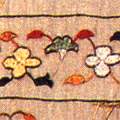
-
The visualisation of the theme to be embroidered.
-
The outlining of the initial drawing in charcoal by a trained miniature artist.
-
The predetermination of a colour palette to be used while embroidering the rumal.
-
The actual embroidering of the rumal by the elite women along the designs sketched in charcoal by miniature artists.
2. CLOTH, THREADS & STITCHES The fabric used to make the Chamba rumal was hand-spun or hand-woven unbleached thin muslin or malmal. The thread used for the embroidery was untwisted silken yarn, which, in the do-rukha stitch used in Chamba embroidery, has a three-dimensional effect, creating tones of light and shade. This untwisted silk thread - usually made in Sialkot, Amritsar, and Ludhiana - was the same as that used in the Phulkari embroidery of the Punjab.
The stitch used in embroidering the Chamba rumal was the do-rukha, a double satin stitch, which, as its name implies, can be viewed from two (do) sides or aspects (rukh). The stitch is carried both backward and forward and covers both sides of the cloth, effecting a smooth finish that is flat and looks like colours filled into a miniature painting. No knots are visible, and the embroidered rumal can be viewed from both sides. It thus becomes reversible. A simple stem stitch using black silk thread is used to outline the figures. Other stitches like the cross stitch, the button-hole stitch, the long and short stitch, and the herring-bone stitch, as well as pattern darning, were also used occasionally.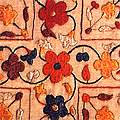

-
Ganesha: The mythical Hindu god with the head of an elephant is represented with the main figure 'placed under a scalloped arch, with a green-leaved tree serving as an umbrella'. (Original rumal in the Indian Museum, Kolkata.)
-
Shikar: Representing a pastime common to royalty and feudal lords, shikar depictions represent ' a lively scene of movement', with details that include the 'variety of prey, the different weapons used, variegated colours for the animals [and the foliage] as well as the patterns of [the] dresses [worn by] the hunters'. (Original rumal in the Indian Museum, Kolkata.)
-
Godhuli: Literally, 'the hour of cow-dust', this refers to a rural scene: the cloud of dust that is raised when the cows return home at dusk. Often Krishna and his cow-herd friends are depicted bringing back the cows, a picturisation made more colourful by depictions of women watching, birds flying, nad fish swimming in the water. (Original rumal in the Calico Museum, Ahmedabad.)
-
Radha-Krishna: The depiction of Radha and Krishna on a pavilion is extremely colourful. The pavilion is two-tiered: Radha and Krishna, with attendants are on the first pavilion, while music and other activities are taking place on the ground floor. Depictions of trees, peacocks, and birds indicate that the pavilion is in the garden. (Original rumal in the National Museum, New Delhi.)
-
Raasmandala with Lakshmi-Narayana
- The raasmandala or the various raaslilas of Krishna are popular subjects, especially as they combine colour, activity, and movement. In the rumal that depicts the Raasmandala with Lakshmi-Narayana, a 'four armed Vishnu and Lakshmi are seated on a double-petalled lotus, flanked by adoring monkeys). Around them dance five blue-skinned Krishnas, interspersed with five gopis. There is a 'male drummer in the forefront', and 'women musicians in ecah corner'. 'The spaces are interspersed with beautiful flowering shrubs and peacocks' in vibrant colours. (Original rumal in the Indian Museum, Kolkata.)
-
Parijata Hara: Parijata or kalpa-vriksha, the boon-giving tree, was 'one of the treasures churned out of the ocean' in the great samudra-mathan (samudra = ocean; manthan = to churn). The tree was taken by the God of war (and rain), Indra, for his garden. The story depicted by the rumal is that of the theft (haran = abduction/theft) of the tree by Krishna, and the ensuing fight in the heavens between Indra ('seated on his white elephant') and Krishna ('seated on Garuda'). (Original rumal in the Crafts Museum, New Delhi.)
-
Jagannatha: This depicts the divine triad of the Jagannath temple at Puri (Odisha) - Jagannath, Subhadra, and Balaram - with bowls of offerings placed before them. 'The first floor enshrines the crowned figure of Krishna along with Radha. (Original rumal in the Bhuri Singh Museum, Chamba.)
-
Chaupad: This is a representation of the game of Chaupad or dice that was popular in the Chamba area The X-shaped base on which the game was played is depicted in detail; [f ]our couples, smoking hukkas (pipes) are shown playing the game.' (Original rumal in the Bhuri Singh Museum, Chamba.)
-
Ashtanayika: Representing the popular subject of 'nayika-bheda' (various moods of the nayika), this has 'eight drum-shaped panels in two rows'. Each cell depicts the nayika in a distinct mood and in varied surroundings. The moods are depicted through expressions, gestures, and through surrounding motifs, including the peacock and doves. (Original rumal in the Bhuri Singh Museum, Chamba.)
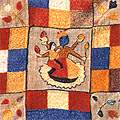
-
So far, the oldest dated rumal is a 16th century creation that is supposed to have been embroidered by Bebe Nanki, the sister of Guru Nanak, the founder of the Sikh faith in India. This is now preserved in the Sikh shrine in Gurdaspur in Punjab.
-
A rumal depicting the battle of Kurukshetra - from the Indian epic Mahabharata - is to be found at the Victoria and Albert Museum in London. This oblong piece is supposed to have been presented by Raja Gopal Singh of Chamba to the British in 1833.
- Bhuri Singh Museum, Chamba (Himachal Pradesh, India)
- Crafts Museum, New Delhi (Delhi, India)
- Government Museum, Shimla (Himachal Pradesh, India)
- Indian Museum, Kolkata (West Bengal, India)
- National Museum, New Delhi (Delhi, India)
- Victoria & Albert Museum, London (United Kingdom)
- Textual & Photographic Material on the rumal is available with the Delhi Crafts Council.
Champa Silk Saree are peculiar to the state of Chattisgarh. The saree is developed from wild tussar silk (Antheraea mylitta). Since the texture of the yarn is rough, the saree too has a rough texture. The patterning is done with contrasting extra weft yarns on jacquard looms. The designs are inspired by tribal motifs. The product range developed out of tussar silk includes a wide range of sarees, dress materials, stoles, dupattas and home furnishings.
The gossamer-like chanderi derives its name from ancient town of Chanderi in Guna district of Madhya Pradesh. The fine chanderi has been compared with the fine Dhaka/Dacca muslin (which could pass through a ring).
| FIELD | BORDER | END-PIECE | |
| Lightest Muslin | Plain | Very narrow border of complementary-warp zari | Few narrow zari bands, or one single wider band. |
| Common Chanderi | Buttis appear in the field | Broader borders in supplementary-warp zari, with coloured supplementary-warp silk embellishments woven into small, repeat geometrical or floral designs | Border elements repeated twice, often with narrow woven lines and buttis. Minakari [inlay] effect most common in this. |
| Do Chashmee Two Streams (NO LONGER MADE) | Wide borders with brightly-coloured supplementary-warp silk in a satin weave upon which were supplementary bands of white geometric patterns. (In some saris the borders were reversible). | Relatively insignificant: with either two narrow or one wide band of zari or coloured silk woven in |

